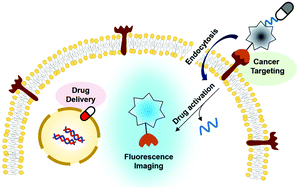当前位置:
X-MOL 学术
›
Chem. Soc. Rev.
›
论文详情
Our official English website, www.x-mol.net, welcomes your feedback! (Note: you will need to create a separate account there.)
Fluorogenic reaction-based prodrug conjugates as targeted cancer theranostics
Chemical Society Reviews ( IF 46.2 ) Pub Date : 2017-10-23 00:00:00 , DOI: 10.1039/c7cs00557a Min Hee Lee 1 , Amit Sharma , Min Jung Chang , Jinju Lee , Subin Son , Jonathan L Sessler , Chulhun Kang , Jong Seung Kim
Chemical Society Reviews ( IF 46.2 ) Pub Date : 2017-10-23 00:00:00 , DOI: 10.1039/c7cs00557a Min Hee Lee 1 , Amit Sharma , Min Jung Chang , Jinju Lee , Subin Son , Jonathan L Sessler , Chulhun Kang , Jong Seung Kim
Affiliation

|
Theranostic systems are receiving ever-increasing attention due to their potential therapeutic utility, imaging enhancement capability, and promise for advancing the field of personalized medicine, particularly as it relates to the diagnosis, staging, and treatment of cancer. In this Tutorial Review, we provide an introduction to the concepts of theranostic drug delivery effected via use of conjugates that are able to target cancer cells selectively, provide cytotoxic chemotherapeutics, and produce readily monitored imaging signals in vitro and in vivo. The underlying design concepts, requiring the synthesis of conjugates composed of imaging reporters, masked chemotherapeutic drugs, cleavable linkers, and cancer targeting ligands, are discussed. Particular emphasis is placed on highlighting the potential benefits of fluorogenic reaction-based targeted systems that are activated for both imaging and therapy by cellular entities, e.g., thiols, reactive oxygen species and enzymes, which are present at relatively elevated levels in tumour environments, physiological characteristics of cancer, e.g., hypoxia and acidic pH. Also discussed are systems activated by an external stimulus, such as light. The work summarized in this Tutorial Review will help define the role fluorogenic reaction-based, cancer-targeting theranostics may have in advancing drug discovery efforts, as well as improving our understanding of cellular uptake and drug release mechanisms.
中文翻译:

基于荧光反应的前药缀合物作为靶向癌症治疗学
治疗诊断系统因其潜在的治疗效用、成像增强能力以及推进个性化医疗领域的前景而受到越来越多的关注,特别是因为它与癌症的诊断、分期和治疗有关。在本教程回顾中,我们介绍了通过使用缀合物实现治疗诊断药物递送的概念,该缀合物能够选择性地靶向癌细胞,提供细胞毒性化疗药物,并在体外和体内产生易于监测的成像信号。讨论了基本的设计概念,需要合成由成像报告分子、掩蔽化疗药物、可裂解接头和癌症靶向配体组成的缀合物。特别强调强调基于荧光反应的靶向系统的潜在益处,该系统通过细胞实体(例如硫醇、活性氧和酶)激活用于成像和治疗,这些细胞实体在肿瘤环境、生理学和生理学中以相对较高的水平存在。癌症的特征,例如缺氧和酸性pH。还讨论了由外部刺激(例如光)激活的系统。本教程综述中总结的工作将有助于定义基于荧光反应的癌症靶向治疗诊断学在推进药物发现工作以及提高我们对细胞摄取和药物释放机制的理解中可能发挥的作用。
更新日期:2017-10-23
中文翻译:

基于荧光反应的前药缀合物作为靶向癌症治疗学
治疗诊断系统因其潜在的治疗效用、成像增强能力以及推进个性化医疗领域的前景而受到越来越多的关注,特别是因为它与癌症的诊断、分期和治疗有关。在本教程回顾中,我们介绍了通过使用缀合物实现治疗诊断药物递送的概念,该缀合物能够选择性地靶向癌细胞,提供细胞毒性化疗药物,并在体外和体内产生易于监测的成像信号。讨论了基本的设计概念,需要合成由成像报告分子、掩蔽化疗药物、可裂解接头和癌症靶向配体组成的缀合物。特别强调强调基于荧光反应的靶向系统的潜在益处,该系统通过细胞实体(例如硫醇、活性氧和酶)激活用于成像和治疗,这些细胞实体在肿瘤环境、生理学和生理学中以相对较高的水平存在。癌症的特征,例如缺氧和酸性pH。还讨论了由外部刺激(例如光)激活的系统。本教程综述中总结的工作将有助于定义基于荧光反应的癌症靶向治疗诊断学在推进药物发现工作以及提高我们对细胞摄取和药物释放机制的理解中可能发挥的作用。


























 京公网安备 11010802027423号
京公网安备 11010802027423号